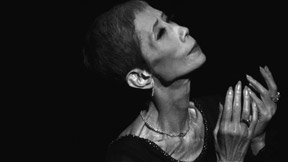And Then Akiko Is . . . A Portrait of a Dancer
(Soshite akiko wa . . . Aru dancer no shozo) JAPAN / 2012 / Japanese / Color / Blu-ray / 120 min
JAPAN / 2012 / Japanese / Color / Blu-ray / 120 min
Director: Haneda Sumiko
Photogyaphy: Soda Kikumatsu, Kawato Koichiro
Sound: Takizawa Osamu
Producer: Kudo Mitsuru
Production Company, World Sales: Jiyu Kobo www.jiyu-kobo.com
Filmmaker Haneda Sumiko returns to film Akiko Kanda, a groundbreaking figure of Japanese modern dance. Following up on her 1985 film Akiko: Portrait of a Dancer, the director began this documentary in the fall of 2010, profiling Akiko, who had now reached her mid-70s. Akiko is diagnosed with cancer and is hospitalized as filming begins. Her commitment to dance does not waver, even while continuing outpatient treatment. She begins to commute between the hospital and the stage. Akiko’s life came to a close following the opening of her show in the fall of 2011. The filmmaker documents Akiko’s final days and her childlike innocence, as well as her steadfast and serious relationship with dance.
 [Director’s Statement] This film is a documentary chronicling the life of Akiko Kanda, a trailblazing figure of Japanese modern dance. This work was shown at the 25th—and sadly, last—Tokyo International Women’s Film Festival in October of 2012. This is the second time I have chosen Akiko-san as a subject for a film, the first time being Akiko: Portrait of a Dancer in 1985, which coincidentally screened at the inaugural Tokyo International Women’s Film Festival.
[Director’s Statement] This film is a documentary chronicling the life of Akiko Kanda, a trailblazing figure of Japanese modern dance. This work was shown at the 25th—and sadly, last—Tokyo International Women’s Film Festival in October of 2012. This is the second time I have chosen Akiko-san as a subject for a film, the first time being Akiko: Portrait of a Dancer in 1985, which coincidentally screened at the inaugural Tokyo International Women’s Film Festival.
I still remember when I first saw Akiko in her dance studio, with my producer Kudo Mitsuru. I was enchanted. I felt the power of the universe being channeled there. When I first spoke with her, I was surprised again to hear her child like voice. She came to call me “Mom,” and Kudo “Dad.”
My relationship with Akiko continued after that first film, and I never missed her performances. In November 2010, Kudo became ill and had to miss Akiko’s show. He asked me to record the performance, and Akiko agreed to the filming. It was only the day after that performance that Akiko was hospitalized and I was shocked to learn she hadn’t told me of her lung cancer. It was then that I began work on this second film.
Finishing this film became a tremendously painful experience. In the editing room, I watched footage that had captured Akiko’s gentle nature, in every scene. Seeing her dance in the September 2011 performance that would be her last, made Akiko’s impending death scarcely believable. In the end, this film became something unexpected. Yet, I believe it stays true to the spirit of Akiko, who had once told me, “I would be the happiest person in the world, if I could say ‘Dance is my philosophy.’”
 Haneda Sumiko
Haneda Sumiko
Born 1926 in Dalian, China. Graduate of Jiyu Gakuen. After graduating, Haneda Sumiko joined the newly established Iwanami Productions where she began to work with documentaries through editing the Iwanami Shashin Bunko. Haneda’s first work as director was Women’s College in the Village (1957). Her debut as an independent filmmaker was The Cherry Tree with Gray Blossoms (1977, YIDFF ’95). She left Iwanami Productions in 1981, becoming a freelance documentary filmmaker. Haneda’s other films include Ode to Mt. Hayachine (1982), Akiko: Portrait of a Dancer (1985), How to Care for the Senile (1986), Getting Old without Anxiety (1990), Kabuki Actor Nizaemon (6 parts, 1991–94), Woman Was the Sun—The Life of Hiratsuka Raicho (2001), Into the Picture Scroll—The Tale of Yamanaka Tokiwa (2004, YIDFF 2005), The Takanosu-machi Thereafter (2005–06), A Story of Manchurian Settler Communities (2008), and Harukanaru furusato: Ryojun Dairen (2011). Haneda served as juror for the International Competition at YIDFF ’99.
